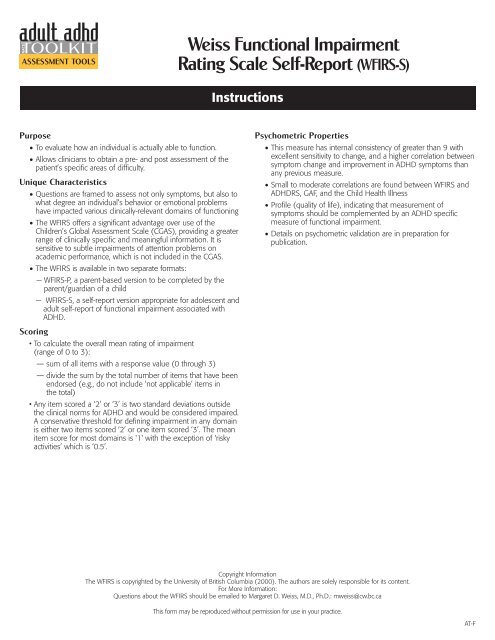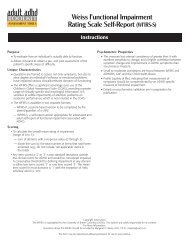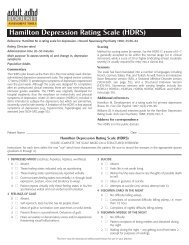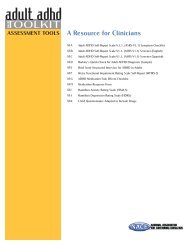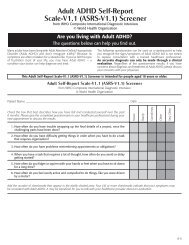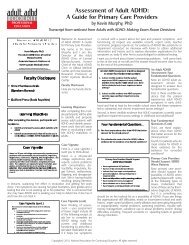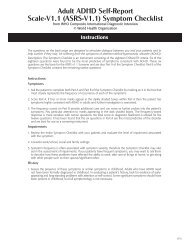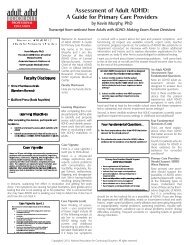Weiss Functional Impairment Rating Scale Self-Report (WFIRS-S)
Weiss Functional Impairment Rating Scale Self-Report (WFIRS-S)
Weiss Functional Impairment Rating Scale Self-Report (WFIRS-S)
Create successful ePaper yourself
Turn your PDF publications into a flip-book with our unique Google optimized e-Paper software.
ASSESSMENT TOOLS<strong>Weiss</strong> <strong>Functional</strong> <strong>Impairment</strong><strong>Rating</strong> <strong>Scale</strong> <strong>Self</strong>-<strong>Report</strong> (<strong>WFIRS</strong>-S)InstructionsPurposeTo evaluate how an individual is actually able to function.Allows clinicians to obtain a pre- and post assessment of thepatient’s specific areas of difficulty.Unique CharacteristicsQuestions are framed to assess not only symptoms, but also towhat degree an individual’s behavior or emotional problemshave impacted various clinically-relevant domains of functioningThe <strong>WFIRS</strong> offers a significant advantage over use of theChildren’s Global Assessment <strong>Scale</strong> (CGAS), providing a greaterrange of clinically specific and meaningful information. It issensitive to subtle impairments of attention problems onacademic performance, which is not included in the CGAS.The <strong>WFIRS</strong> is available in two separate formats:— <strong>WFIRS</strong>-P, a parent-based version to be completed by theparent/guardian of a child— <strong>WFIRS</strong>-S, a self-report version appropriate for adolescent andadult self-report of functional impairment associated withADHD.Scoring• To calculate the overall mean rating of impairment(range of 0 to 3): sum of all items with a response value (0 through 3) divide the sum by the total number of items that have beenendorsed (e.g., do not include ‘not applicable’ items inthe total)• Any item scored a ‘2’ or ‘3’ is two standard deviations outsidethe clinical norms for ADHD and would be considered impaired.A conservative threshold for defining impairment in any domainis either two items scored ‘2’ or one item scored ‘3’. The meanitem score for most domains is '1' with the exception of 'riskyactivities’ which is ‘0.5’.Psychometric PropertiesThis measure has internal consistency of greater than 9 withexcellent sensitivity to change, and a higher correlation betweensymptom change and improvement in ADHD symptoms thanany previous measure.Small to moderate correlations are found between <strong>WFIRS</strong> andADHDRS, GAF, and the Child Health IllnessProfile (quality of life), indicating that measurement ofsymptoms should be complemented by an ADHD specificmeasure of functional impairment.Details on psychometric validation are in preparation forpublication.Copyright InformationThe <strong>WFIRS</strong> is copyrighted by the University of British Columbia (2000). The authors are solely responsible for its content.For More Information:Questions about the <strong>WFIRS</strong> should be emailed to Margaret D. <strong>Weiss</strong>, M.D., Ph.D.: mweiss@cw.bc.caThis form may be reproduced without permission for use in your practice.AT-F
<strong>Weiss</strong> <strong>Functional</strong> <strong>Impairment</strong> <strong>Rating</strong> <strong>Scale</strong> – <strong>Self</strong>-<strong>Report</strong> (<strong>WFIRS</strong>-S)Used by permission from the authors by CADDRA for unlimited use by its members.Patient Name __________________________________________________________ Date ___________________ Age ______________Sex: ■ Male ■ Female GENERAL INFORMATION Yes No N/ADo you have at least monthly contact with your family? ■ ■ ■Do you spend time weekly with other people? ■ ■ ■Do you live alone? ■ ■ ■Have you been employed in the last year? ■ ■ ■Have you been in school in the last year? ■ ■ ■Circle the number for the rating thatbest describes how your emotionalor behavioural problems haveaffected each item in the last month.A. HOMENever orNot at AllSometimes orSomewhatHow have your emotional or behavioural symptoms affected…1. family relationships 0 1 2 3 ■2. dependency on other people 0 1 2 3 ■3. the well being of members of your family 0 1 2 3 ■4. fighting in the family 0 1 2 3 ■5. ability for the family to socialize 0 1 2 3 ■6. your ability to look after others 0 1 2 3 ■7. balancing the needs of all family members 0 1 2 3 ■8. your ability to “keep cool” orrefrain from rages 0 1 2 3 ■B. YOUR SELF-CONCEPTOften or MuchVery Often orVery MuchHow have your emotional or behavioural symptoms affected…1. whether you like yourself 0 1 2 3 ■2. whether you feel competent 0 1 2 3 ■3. your ability to have fun and enjoy yourself 0 1 2 3 ■4. your general satisfaction with life 0 1 2 3 ■C. LEARNING & WORKHow have your emotional or behavioural symptoms affected…1. your ability to perform well atwork or school 0 1 2 3 ■2. your productivity and efficiencyat work or in school 0 1 2 3 ■3. your ability to maintain stableemployment 0 1 2 3 ■4. getting fired from work orbeing asked to leave school 0 1 2 3 ■5. receiving reprimands frompeople in authority 0 1 2 3 ■6. the effectiveness of people around you 0 1 2 3 ■7. your attendance at work or school 0 1 2 3 ■8. your ability to take in new information 0 1 2 3 ■9. your capacity to work at your potential 0 1 2 3 ■10. your income or how much moneyyou make 0 1 2 3 ■11. being demoted at work orfailing courses at school 0 1 2 3 ■12. your competence as measuredby evaluations 0 1 2 3 ■Not ApplicableD. ACTIVITIES OF DAILY LIVINGNever orNot at AllSometimes orSomewhatHow have your emotional or behavioural symptoms affected…1. excessive use of computer or videogames, internet, messaging,chat groups, etc. 0 1 2 3 ■2. being clumsy or accident prone 0 1 2 3 ■3. personal hygiene (bathing,hair,teeth, nails) 0 1 2 3 ■4. seeing your doctor/dentist regularly 0 1 2 3 ■5. your ability to get ready in the morning 0 1 2 3 ■6. your ability to get to bed 0 1 2 3 ■7. your sleeping habits 0 1 2 3 ■8. your eating habits 0 1 2 3 ■9. shopping 0 1 2 3 ■10. chores 0 1 2 3 ■11. tidiness and being organized 0 1 2 3 ■12. managing money 0 1 2 3 ■13. your driving behaviour 0 1 2 3 ■14. your health in general 0 1 2 3 ■E. SOCIAL ACTIVITIESOften or MuchVery Often orVery MuchHow have your emotional or behavioural symptoms affected…1. getting along with people you encounter 0 1 2 3 ■2. getting into arguments 0 1 2 3 ■3. your ability to go out and have fun 0 1 2 3 ■4. participating in hobbies and recreation 0 1 2 3 ■5. your ability to make friends 0 1 2 3 ■6. your ability to keep friends 0 1 2 3 ■Not Applicable
F. RISKY ACTIVITIESNever orNot at AllSometimes orSomewhatOften or MuchVery Often orVery MuchHave you had problems with…1. others talking you into doingthings that get you into trouble 0 1 2 3 ■2. breaking or damaging things 0 1 2 3 ■3. doing things that are illegal 0 1 2 3 ■4. being involved with the police 0 1 2 3 ■5. smoking cigarettes 0 1 2 3 ■6. drinking alcohol 0 1 2 3 ■7. smoking marijuana 0 1 2 3 ■8. using other street drugs 0 1 2 3 ■9. complaints from neighbours 0 1 2 3 ■10. sex without protection (birthcontrol, condom) 0 1 2 3 ■11. sexually inappropriate behaviour 0 1 2 3 ■12. being physically aggressive 0 1 2 3 ■13. being verbally aggressive 0 1 2 3 ■Not ApplicableDO NOT WRITE IN THIS AREAA. Home ____________B. <strong>Self</strong>-concept ____________C. Learning & chool ____________D. Activities of daily living ____________E. Social activities ____________F. Risky activities ____________Total ____________


